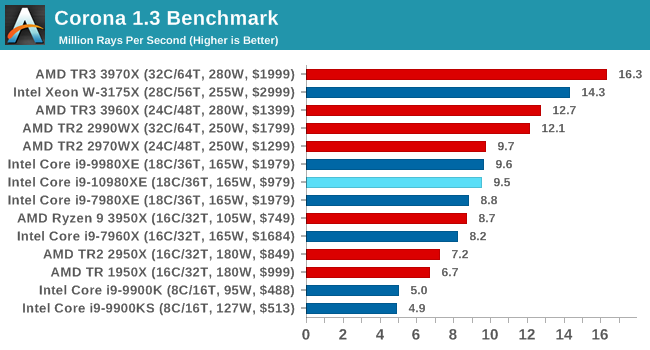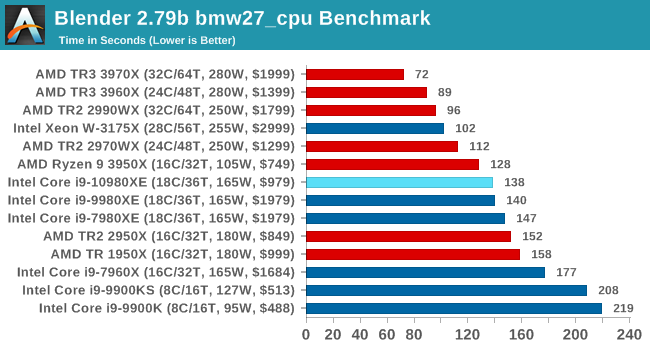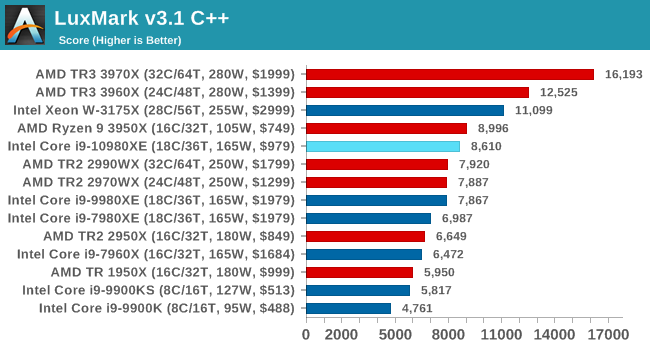It’s a Cascade of 14nm CPUs: AnandTech’s Intel Core i9-10980XE Review
by Dr. Ian Cutress on November 25, 2019 9:00 AM ESTCPU Performance: Rendering Tests
Rendering is often a key target for processor workloads, lending itself to a professional environment. It comes in different formats as well, from 3D rendering through rasterization, such as games, or by ray tracing, and invokes the ability of the software to manage meshes, textures, collisions, aliasing, physics (in animations), and discarding unnecessary work. Most renderers offer CPU code paths, while a few use GPUs and select environments use FPGAs or dedicated ASICs. For big studios however, CPUs are still the hardware of choice.
All of our benchmark results can also be found in our benchmark engine, Bench.
Corona 1.3: Performance Render
An advanced performance based renderer for software such as 3ds Max and Cinema 4D, the Corona benchmark renders a generated scene as a standard under its 1.3 software version. Normally the GUI implementation of the benchmark shows the scene being built, and allows the user to upload the result as a ‘time to complete’.
We got in contact with the developer who gave us a command line version of the benchmark that does a direct output of results. Rather than reporting time, we report the average number of rays per second across six runs, as the performance scaling of a result per unit time is typically visually easier to understand.
The Corona benchmark website can be found at https://corona-renderer.com/benchmark

The 10980XE sits on par with the 9980XE, but no real difference in performance.
Blender 2.79b: 3D Creation Suite
A high profile rendering tool, Blender is open-source allowing for massive amounts of configurability, and is used by a number of high-profile animation studios worldwide. The organization recently released a Blender benchmark package, a couple of weeks after we had narrowed our Blender test for our new suite, however their test can take over an hour. For our results, we run one of the sub-tests in that suite through the command line - a standard ‘bmw27’ scene in CPU only mode, and measure the time to complete the render.
Blender can be downloaded at https://www.blender.org/download/

Again, pretty much on par with the 9980XE.
LuxMark v3.1: LuxRender via Different Code Paths
As stated at the top, there are many different ways to process rendering data: CPU, GPU, Accelerator, and others. On top of that, there are many frameworks and APIs in which to program, depending on how the software will be used. LuxMark, a benchmark developed using the LuxRender engine, offers several different scenes and APIs.
In our test, we run the simple ‘Ball’ scene. This scene starts with a rough render and slowly improves the quality over two minutes, giving a final result in what is essentially an average ‘kilorays per second’.

We see a small uplift here compared to the 9980XE, but the 10980XE still sits behind the 3950X.
POV-Ray 3.7.1: Ray Tracing
The Persistence of Vision ray tracing engine is another well-known benchmarking tool, which was in a state of relative hibernation until AMD released its Zen processors, to which suddenly both Intel and AMD were submitting code to the main branch of the open source project. For our test, we use the built-in benchmark for all-cores, called from the command line.
POV-Ray can be downloaded from http://www.povray.org/

Another parity between the 10980XE and the 9980XE.











79 Comments
View All Comments
rolfaalto - Monday, November 25, 2019 - link
For me the most important CPU features are AVX512, very high Ghz, and lots of fast memory. Plenty of PCI lanes are a significant plus, because they feed all the Volta GPUs ... which of course are PCIe-3. I don't care much about high core counts because that's the point of the GPUs. Mainly I need a few very fast cores to handle all the stuff that can't be massively parallelized. So, this chip checks all the boxes, especially at half the price! :-)blobcat - Monday, November 25, 2019 - link
Looking at the retailers today, the price landed at about $60 higher than prices listed here (and everywhere else leading up to release). 10900x is $649, 10920x is $749, etcIrata - Monday, November 25, 2019 - link
That's because the price given was a price when buying 1,000 units. I think the article even stated that.Holliday75 - Monday, November 25, 2019 - link
It says the following at the bottom of page 1."*Intel quotes OEM/tray pricing. Retail pricing will sometimes be $20-$50 higher."
blobcat - Monday, November 25, 2019 - link
Yes I saw that, but thought it might be helpful to some to know actual retail pricing. Also worth noting that the markup landed at the high end of the range given and then some.Dorkaman - Monday, November 25, 2019 - link
How about some overclocking prime95 non avx stable. I'd love to see it against an overclocked 9900KS in games and rendering tests.Dionysos1234 - Monday, November 25, 2019 - link
Why no discussion of (lack of) ecc memory support?Jorgp2 - Monday, November 25, 2019 - link
That's probably baked into the chipset, and couldn't be added in if they wanted to.That's just Intel's idiotic product segmentation from the original launch biting them in the ass.
SBKch - Monday, November 25, 2019 - link
Could you add Ryzen 3950X to web benchmarks as I've noticed that it's missing?Sychonut - Monday, November 25, 2019 - link
Awesome! Looking forward to next generation on 14+++++++.